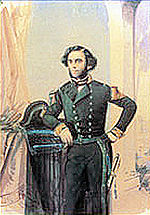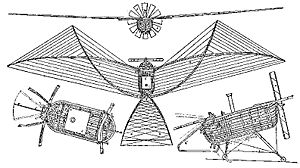
Félix du Temple de la Croix
Encyclopedia

France
The French Republic , The French Republic , The French Republic , (commonly known as France , is a unitary semi-presidential republic in Western Europe with several overseas territories and islands located on other continents and in the Indian, Pacific, and Atlantic oceans. Metropolitan France...
naval officer and an inventor, born into an ancient Normandy
Normandy
Normandy is a geographical region corresponding to the former Duchy of Normandy. It is in France.The continental territory covers 30,627 km² and forms the preponderant part of Normandy and roughly 5% of the territory of France. It is divided for administrative purposes into two régions:...
family. He developed some of the first flying machine
First flying machine
There are conflicting views as to what was the first flying machine.Much of the debate surrounding records of early flying machines depends on the exact definition of what constitutes a "flying machine", "flight", and even "first"....
s: he is credited with the first successful flight of a powered aircraft of any sort, a powered model plane, in 1857, and is sometimes credited with the first manned powered flight in history onboard his Monoplane in 1874,
twenty-nine years before the 1903 flight of the Wright brothers
Wright brothers
The Wright brothers, Orville and Wilbur , were two Americans credited with inventing and building the world's first successful airplane and making the first controlled, powered and sustained heavier-than-air human flight, on December 17, 1903...
.
He was a contemporary of Jean-Marie Le Bris
Jean-Marie Le Bris
Jean-Marie Le Bris was a French aviator, born in Concarneau, Brittany, who accomplished a glider flight in December 1856.- Life and works :...
, another French flight pioneer who was active in the same region of France.
Military life

École Navale
The École Navale is the French Naval Academy in charge of the education of the officers of the French Navy.The academy was founded in 1830 by the order of King Louis-Philippe...
) in 1838. He participated in most of the conflicts during the Second French Empire
Second French Empire
The Second French Empire or French Empire was the Imperial Bonapartist regime of Napoleon III from 1852 to 1870, between the Second Republic and the Third Republic, in France.-Rule of Napoleon III:...
, especially the Crimean War
Crimean War
The Crimean War was a conflict fought between the Russian Empire and an alliance of the French Empire, the British Empire, the Ottoman Empire, and the Kingdom of Sardinia. The war was part of a long-running contest between the major European powers for influence over territories of the declining...
, the French intervention in Italy against Austria, and the French intervention in Mexico
French intervention in Mexico
The French intervention in Mexico , also known as The Maximilian Affair, War of the French Intervention, and The Franco-Mexican War, was an invasion of Mexico by an expeditionary force sent by the Second French Empire, supported in the beginning by the United Kingdom and the Kingdom of Spain...
.
At the age of 41, he returned to France, became a captain (Capitaine de Frégate), and joined the Loire Army (Armée de la Loire
Armée de la Loire
The Armée de la Loire was a French army of the Franco-Prussian War. It was formed in October 1870 by Léon Gambetta, interior minister and minister for war in the Government of National Defence, then taking refuge in Tours after the French defeat at Sedan on 2 September 1870...
). A partisan of the Comte de Chambord and a legitimist (an "Ultra-Royalist"), he was forced to quit the Navy in 1876.
Flying machine patent

John Stringfellow
John Stringfellow was born in Sheffield, England and is known for his work on the Aerial Steam Carriage with William Samuel Henson....
's experiments in 1848.
Félix du Temple patented the designs for his aerial machine in 1857, which incorporated a retractable wheel landing gear, a propeller, a 6 hp engine and a dihedral wing design, under the title "Locomotion aérienne par imitation du vol des oiseaux" ("Aerial locomotion by imitation of the flight of birds"). He built several large models together with his brother Luis. One of them, weighing 700 grams, was able to fly, first using a clockwork mechanism as an engine, and then using a miniature steam engine
Steam engine
A steam engine is a heat engine that performs mechanical work using steam as its working fluid.Steam engines are external combustion engines, where the working fluid is separate from the combustion products. Non-combustion heat sources such as solar power, nuclear power or geothermal energy may be...
. The two brothers managed to make the models take off under their own power, fly a short distance and land safely.
As they tried to build a unit capable of carrying a man, they realized that steam engines lacked power and were too heavy. They developed in 1867 an original "hot air
Stirling engine
A Stirling engine is a heat engine operating by cyclic compression and expansion of air or other gas, the working fluid, at different temperature levels such that there is a net conversion of heat energy to mechanical work....
" engine design, which did not prove satisfactory. They also experimented with the new internal combustion gas engine
Internal combustion engine
The internal combustion engine is an engine in which the combustion of a fuel occurs with an oxidizer in a combustion chamber. In an internal combustion engine, the expansion of the high-temperature and high -pressure gases produced by combustion apply direct force to some component of the engine...
design developed by Lenoir
Etienne Lenoir
-Sources:* Georgano, G.N. Cars: Early and Vintage 1886-1930. London: Grange-Universal, 1990 . ISBN 0-9509620-3-1....
, but which also lacked the necessary power.
Du Temple continued his research and finally succeeded in creating a very compact, high-speed circulation steam engine for which he applied for a patent on 28 April 1876. The engine used very small pipes packed together "to obtain the highest possible contact surface for the smallest possible volume"
- "When he began with the aid of his brother, M. Louis du Temple, to experiment on a large scale, the inadequacy of all motors then known became apparent. They first tried steam at very high pressures, then a hot-air engine, and finally built and patented, in 1876 a very light steam boiler weighing from 39 to 44 lb. to the horse power, which appears to have been the prototype of some of the light boilers which have since been constructed. It consisted in a series of very thin tubes less than 1/8 inches in internal diameter, through which water circulated very rapidly, and was flashed into steam by the surrounding flame." Octave Chanute, Aeroplanes : Part III, August 1892
The "Monoplane"

Monoplane (1874)
The du Temple Monoplane was a large aeroplane made of aluminium, built in Brest, France, by naval officer Félix du Temple in 1874.The plane had a wingspan of 13 m and weighed of only 80 kg without the pilot....
, a large plane made of aluminium
Aluminium
Aluminium or aluminum is a silvery white member of the boron group of chemical elements. It has the symbol Al, and its atomic number is 13. It is not soluble in water under normal circumstances....
in Brest
Brest, France
Brest is a city in the Finistère department in Brittany in northwestern France. Located in a sheltered position not far from the western tip of the Breton peninsula, and the western extremity of metropolitan France, Brest is an important harbour and the second French military port after Toulon...
, France
France
The French Republic , The French Republic , The French Republic , (commonly known as France , is a unitary semi-presidential republic in Western Europe with several overseas territories and islands located on other continents and in the Indian, Pacific, and Atlantic oceans. Metropolitan France...
, with a wingspan
Wingspan
The wingspan of an airplane or a bird, is the distance from one wingtip to the other wingtip. For example, the Boeing 777 has a wingspan of about ; and a Wandering Albatross caught in 1965 had a wingspan of , the official record for a living bird.The term wingspan, more technically extent, is...
of 13 meters and a weight of only 80 kilograms (without the pilot). Several trials were made with the plane, and it is generally recognized that it achieved lift off under its own power after a ski-jump run, glided for a short time and returned safely to the ground, possibly making it the first successful powered flight in history, depending on the definition — since the flight was only a short distance and a short time.
The plane was displayed at the 1878 World Fair (Exposition Universelle (1878)
Exposition Universelle (1878)
The third Paris World's Fair, called an Exposition Universelle in French, was held from 1 May through to 10 November 1878. It celebrated the recovery of France after the 1870 Franco-Prussian War.-Construction:...
) in Paris.
High-circulation steam engine
The plane used a very compact, high-speed circulation steam engineSteam engine
A steam engine is a heat engine that performs mechanical work using steam as its working fluid.Steam engines are external combustion engines, where the working fluid is separate from the combustion products. Non-combustion heat sources such as solar power, nuclear power or geothermal energy may be...
for which Félix du Temple applied for a patent on 28 April 1876. The engine used very small pipes packed together "to obtain the highest possible contact surface for the smallest possible volume".
The original steam engine which had been developed by Félix du Temple was later commercialized by him from a company he established in Cherbourg, "Générateur Du Temple S.A." and became highly successful. The design was adopted by the French Navy
French Navy
The French Navy, officially the Marine nationale and often called La Royale is the maritime arm of the French military. It includes a full range of fighting vessels, from patrol boats to a nuclear powered aircraft carrier and 10 nuclear-powered submarines, four of which are capable of launching...
for the propulsion of the first French torpedo boat
Torpedo boat
A torpedo boat is a relatively small and fast naval vessel designed to carry torpedoes into battle. The first designs rammed enemy ships with explosive spar torpedoes, and later designs launched self-propelled Whitehead torpedoes. They were created to counter battleships and other large, slow and...
s:
- "Officers and engineers have now made up their opinion regarding Du Temple's steam engine. Everybody proclaims the superiority of its qualities… orders are pouring in from our commercial harbours and from the French government." Revue Maritime 1888 ("L’opinion est faite aujourd’hui sur la chaudière Du Temple parmi les officiers et les ingénieurs. Tout le monde proclame ses qualités supérieures… les commandes affluent de nos ports de commerce et de la part du gouvernement français".)
Industrial legacy
Following his death in 1890, his successors took over the management of the company. "Générateur Du Temple S.A.", acquired the Lesénéchal company in 1905, and by 1918 had several hundred employees when it was absorbed by the shipbuilding company Société Normande de Construction Navale.Quote
External links
See also
- List of early flying machines
- First flying machineFirst flying machineThere are conflicting views as to what was the first flying machine.Much of the debate surrounding records of early flying machines depends on the exact definition of what constitutes a "flying machine", "flight", and even "first"....
- Timeline of aviation - 19th centuryTimeline of aviation - 19th centuryThis is a list of aviation-related events during the 19th century :- 1800s :* 1803** British Rear Admiral Charles Henry Knowles proposes to the Admiralty that the Royal Navy loft an observation balloon from a ship in order to reconnoitre French preparations in Brest to invade Great Britain...
- History of aviation

